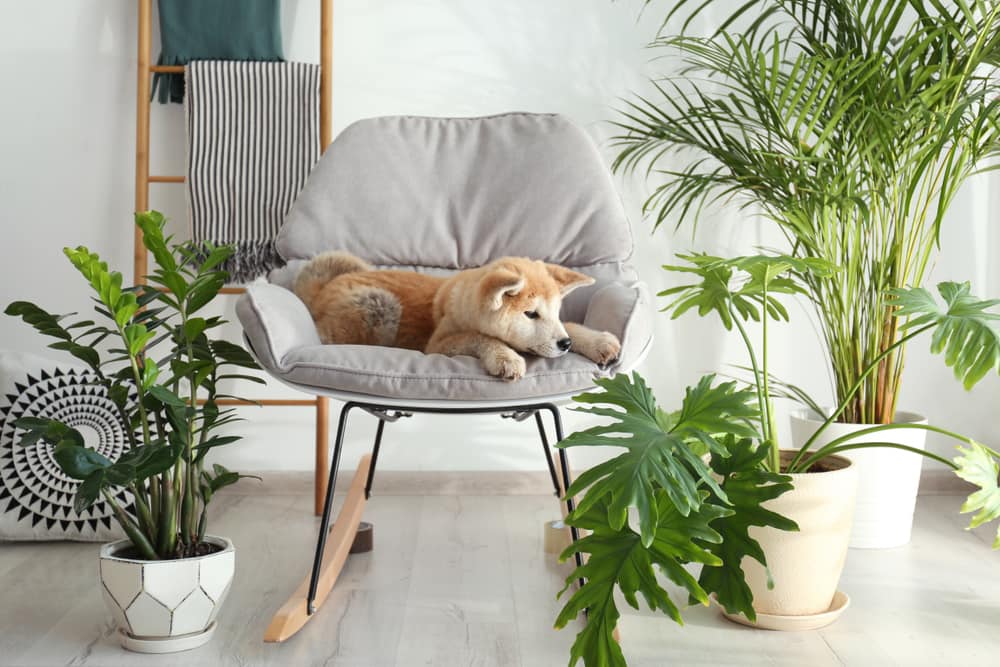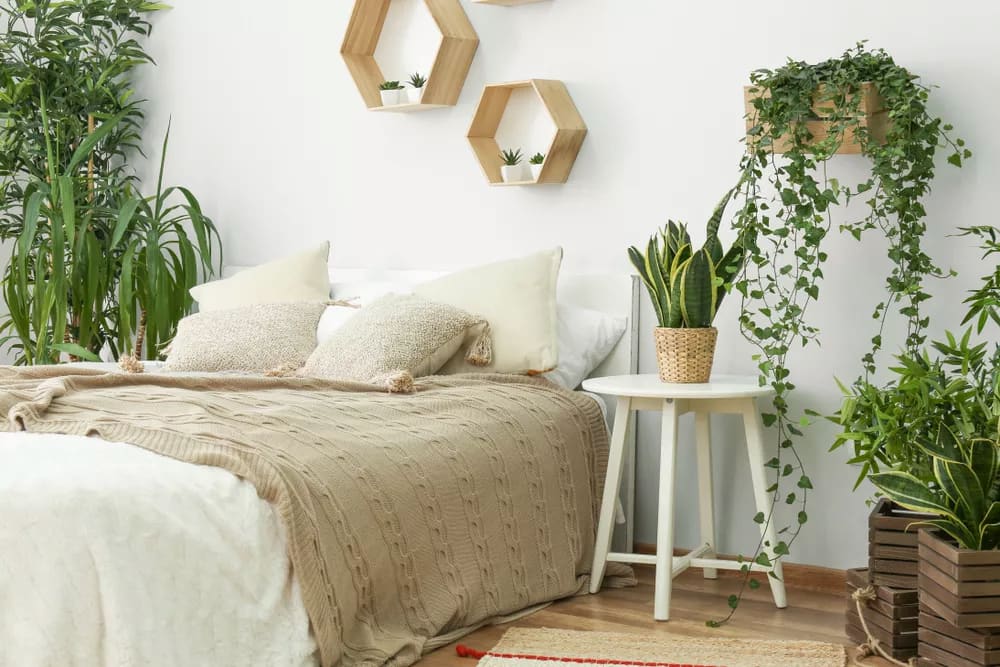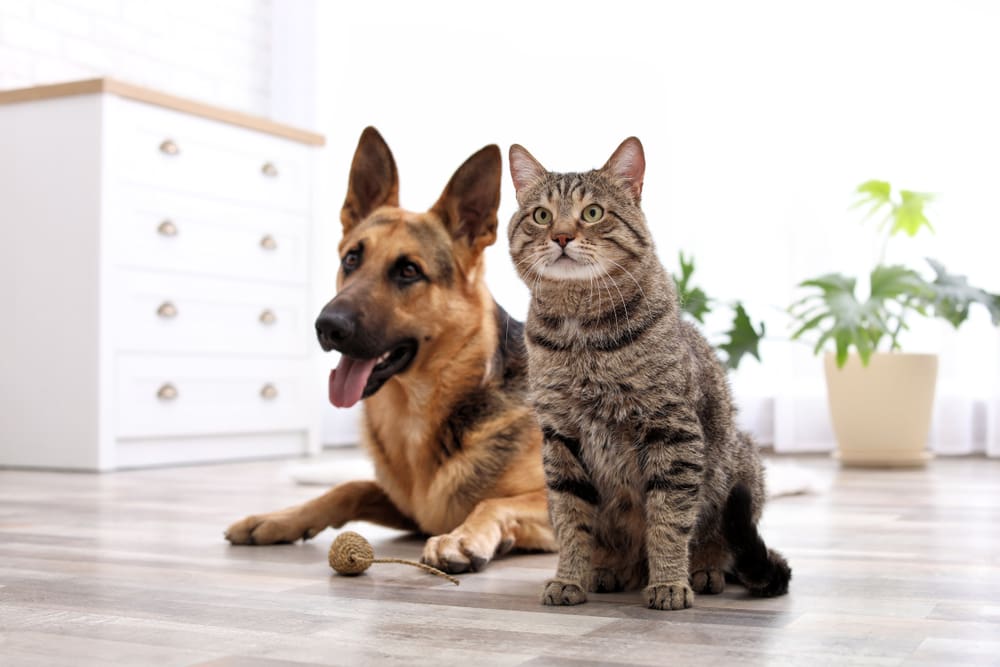Houseplants are a wonderful way to bring life and color into your home, but certain types of plants can present a danger to residents who already live there—your pets. Since there are several houseplants toxic to pets, it’s critical to understand what kinds of plants you’re bringing home and how they’ll impact your pet’s health. Here are 16 non-toxic indoor plants that are perfect for a pet-friendly home!
African Violet
- Alternate Names: Streptocarpus ionanthus (formerly Saintpaulia ionantha)
- Maintenance Level: Intermediate
- Sunlight Amount: Indirect sunlight
- Water Frequency: Weekly
As one of the most popular houseplants, African violets can be a beautiful addition to any home thanks to their vivid violet blooms and soft, velvety leaves. African violets thrive in moderate temperatures with some humidity, making them relatively easy to care for. These non-toxic houseplants appreciate indirect sunlight and warmth, so keep them away from east or west-facing windows and air vents to avoid drying out their leaves. Since African violets can bloom all year long, be sure to maintain their nutrients to keep their petals bright and healthy.
Air Plant
- Alternate Names: Tillandsia (multiple species)
- Maintenance Level: Beginner
- Sunlight Amount: Bright, indirect sunlight
- Water Frequency: Every 1 to 2 weeks
Air plants are a fascinating pet-friendly houseplant that don’t require a lot of maintenance. Though they may resemble certain succulents in appearance, they are different plants with different needs. Air plants don’t root in soil and can take in their nutrients from the air itself, but they can wilt if exposed to too much direct sunlight. When watering air plants, submerge them in room-temperature water for 20 to 40 minutes before shaking off the excess water, or use a spray bottle to thoroughly mist them. Whichever method you choose, allow them to dry completely between waterings. Since they don’t need soil, there are many decorative options for potting air plants, such as shells, hanging terrariums, and more!
Baby’s Tears
- Alternate Names: Soleirolia soleirolii, Helxine soleirolii, angel tears, Paddy’s wig, Pollyanna vine, Corsican creeper
- Maintenance Level: Intermediate
- Sunlight Amount: Indirect sunlight
- Water Frequency: Every five to seven days
The baby’s tears plant is an evergreen creeper with tiny, moss-like leaves that tend to droop over the sides of its pot in beautiful, flowing cascades. Generally low-maintenance—though it is prone to wilting if exposed to the cold or not watered properly—this plant can be an excellent, pet-safe option to add to your urban jungle. Try planting it in hanging baskets or in vivarium enclosures like terrariums and paludariums.
Boston Fern
- Alternate Names: Nephrolepis exaltata, sword fern
- Maintenance Level: Intermediate
- Sunlight Amount: Bright, indirect sunlight
- Water Frequency: Weekly
With its long fanning fronds, the Boston fern is a popular, pet-safe houseplant. But if your furry friends are prone to playing with your plants, the Boston fern’s fronds tend to drape, so they’re ideal for hanging plant baskets or in plant stands to keep them off the floor and away from curious paws and jaws. In the spring and summer, this plant thrives in cool, humid environments with bright, indirect sunlight. Turn your pot periodically to ensure even growth, and keep the soil evenly moist. In the fall and winter, move your fern to a different window with more sunlight to compensate for seasonal changes, and mist it daily or invest in a humidifier to keep it healthy during the cooler months.
Burro’s Tail
- Alternate Names: Sedum morganianum, donkey tail
- Maintenance Level: Intermediate
- Sunlight Amount: Bright, direct sunlight
- Water Frequency: Once every two weeks
Burro’s tail is a sensitive but beautiful type of succulent native to southern Mexico. As such, it appreciates bright, direct sunlight and dry, sandy soil with lots of drainage. Like other succulents, burro’s tail can develop rot if over-watered, so make sure to let the soil dry in between waterings! The plant’s trailing stems are full of tiny, bulbous succulent leaves that are prone to falling off, so it’s best not to allow your pets to play with it even though it won’t hurt them. Fortunately, burro’s tail doesn’t suffer due to root-binding and only needs to be repotted once every couple of years. Mature burro’s tails tend to drape over the sides of its pot, so it’s another great decorative plant to have in a hanging basket or somewhere high up in the home, such as on a bookshelf.
Calathea
- Alternate Names: Goeppertia (multiple species)
- Maintenance Level: Intermediate
- Sunlight Amount: Bright, indirect sunlight
- Water Frequency: Weekly
Calatheas are popular due to their broad, patterned leaves that include striking shades of green, yellow, and silver. This plant is safe for cats and dogs and comes in multiple varieties, including rattlesnakes, Sanderianas, white stars, Freddies, and many others that have recently been reclassified under Goeppertia. As tropical plants, calatheas thrive in warm areas of the home with bright, indirect light—direct sunlight can cause the leaves to brown. For optimal humidity, place your calathea’s pot on a tray of pebbles and add water; you can also mist them regularly with room-temperature water or use a humidifier. Distilled water and rainwater are best for calatheas, since they are sensitive to chemicals that are often found in tap water.
Chinese Money Plant
- Alternate Names: Pilea peperomioides, pancake plant, UFO plant, missionary plant, lefse plant, coin plant
- Maintenance Level: Beginner
- Sunlight Amount: Bright, indirect sunlight
- Water Frequency: Weekly
Named for their round, coin-like leaves that seem to stack on top of each other—as well as the belief they bring good fortune to their owners—Chinese money plants are elegant, low-maintenance, and non-toxic plants to add to your home. Place their pots in indirect sunlight, as too much sun can scorch their beautiful dark green leaves. You can push your finger an inch or so into the soil to determine whether they need to be watered. If the soil is damp, let them be for a few days, since overwatering can cause their leaves to turn yellow or fall off.
Christmas Cactus
- Alternate Names: Schlumbergera (multiple species)
- Maintenance Level: Beginner
- Sunlight Amount: Bright, indirect sunlight
- Water Frequency: Every two to three weeks
Christmas cacti are an excellent decoration year-round, and can add a pop of color to your home at the holidays with their tubular, pink blooms. Since these cacti lack spines and are non-toxic, they’re perfectly safe plants to have around pets! Unlike other cacti, the Schlumbergera cactus is native to moist, tropical rainforests, so it does need water when the top third of the soil feels dry. Water is especially important when the plant is flowering! Give your cactus plenty of drainage, since excess water can be harmful. If pruned in the springtime, you can encourage more branching and flowers. The cuttings can also be propagated in moist soil to be given as a gift to others!
Moth Orchids
- Alternate Names: Phalaenopsis (multiple species)
- Maintenance Level: Intermediate
- Sunlight Amount: Bright, indirect sunlight
- Water Frequency: Every seven to ten days
With stunning colorful or white blooms that last for long periods of time, Phalaenopsis orchids are a non-toxic houseplant you can enjoy without risking your pets’ health. They get their common name, “moth orchid,” from the fact that their vibrant blooms resemble a moth in flight. Preferring indirect light throughout most of the year, moth orchids can be moved to east or south-facing windows during the winter to compensate for lower amounts of sunlight. Too much sunlight, however, can scorch their leaves, so be careful to monitor and rotate them to ensure even growth. In areas where natural light isn’t sufficient, you can also use artificial grow lights. Since this type of orchid grows from a single stem, it’s less drought-tolerant than other plants, so be sure to water it once weekly—or when the soil is dry—and let it drain completely to prevent root rot.
Parlor Palm
- Alternate Names: Chamaedorea elegans, neanthe bella palm
- Maintenance Level: Beginner
- Sunlight Amount: Bright, indirect sunlight
- Water Frequency: Every one to two weeks
Parlor palms are not only safe for pets, but also great houseplants for beginners! Growing up to six feet tall indoors and living several years, they can add a verdant tropical vibe to any home, and they’re one of many air-purifying plants that can help rid your home of airborne toxins. These palms tend to drink more water in growing season, so it’s a good idea to do a finger test before watering to ensure the soil is dry enough. They enjoy bright, indirect sunlight in pots slightly bigger than the root ball, and thrive in neutral to acidic soil with lots of drainage, and mild temperatures between 65 and 75 degrees.
Peperomia
- Alternate Names: N/a
- Maintenance Level: Beginner
- Sunlight Amount: Bright, indirect sunlight
- Water Frequency: Every one to two weeks
Since there are over 1,000 species of peperomia, with popular species including the baby rubber plant (Peperomia obtusifolia), watermelon peperomia (Peperomia argyreia), and trailing jade (Peperomia rotundifolia), their common names are diverse. They tend to have thick green and silver leaves that vary in size from a small coin to a softball. As some of the easiest houseplants to care for, they can add lushness to your home without much maintenance required. Peperomia care does vary by species, but they are native to tropical climates where they grow beneath large trees, so indirect sunlight is best (though be sure to research your species’ preferred conditions on your own). Peperomia also tend to like humidity, making them excellent bathroom or terrarium plants—but be sure to provide plenty of drainage to avoid overwatering.
Polka Dot Plant
- Alternate Names: Hypoestes phyllostachya, freckle face plant, measles plant
- Maintenance Level: Intermediate
- Sunlight Amount: Bright, indirect sunlight or partial shade
- Water Frequency: Every one to two weeks
With bright magenta, pink, red, and white splashes on their variegated leaves, the aptly-named polka dot plants are a great way to give your home a pop of color without posing a danger to your pets. Though they can grow to be quite tall in the wild, they tend to only reach heights of ten inches or so, and one to two feet wide as a houseplant. You can also trim any taller stems to encourage fuller growth. To maintain their vivid colors, be sure to keep polka dot plants in warmer temperatures between 70 and 80 degrees with and bright, indirect light. The trick to this plant is keeping the watering consistent—polka dot plants like moisture, so make sure the top half-inch of soil is dry before watering.
Ponytail Palm
- Alternate Names: Beaucarnea recurvata, elephant’s foot, bottle palm
- Maintenance Level: Beginner
- Sunlight Amount: Full sun or bright, indirect light
- Water Frequency: Every two to three weeks
Ponytail palms are a beginner-friendly plant, as they don’t require much to keep them green and healthy. These dynamic houseplants are characterized by bulbous trunks, long, blades as leaves, and their longevity. Cats in particular may be fond of batting around the long thin leaves, but don’t worry—ponytail palms are safe for pets! Though they have “palm” in their name, they’re actually a kind of succulent and thrive in bright, full sun or even indirect sunlight. Water sparingly and let the soil dry out between waterings—it’s better to under-water than over-water them. Like many other succulents, they need plenty of drainage so their roots don’t get damaged by soaking in water.
Prayer Plant
- Alternate Names: Maranta leuconeura
- Maintenance Level: Intermediate
- Sunlight Amount: Indirect sunlight or partial shade
- Water Frequency: Weekly
Prayer plants are prized for their beautifully-patterned leaves of all shades of green, silver, and pink. Their common name comes from the movement the leaves make—at night, the leaves fold up like hands in prayer. Gorgeous perennials, prayer plants can be finicky about their needs and aren’t necessarily the best options for beginners. Pet parents adding plants to their home should keep in mind prayer plants like moisture, so they need high humidity and to be watered rather frequently or when the first inch of soil becomes dry—in addition to having plenty of drainage to prevent root rot. Prayer plants are low-light plants, preferring indirect sunlight near a window, since their leaves will scorch if exposed to too much sunlight.
Spider Plant
- Alternate Names: Chlorophytum comosum, spider ivy, ribbon plant
- Maintenance Level: Beginner
- Sunlight Amount: Bright, indirect sunlight
- Water Frequency: Once a week
With their long, drooping, striped leaves, spider plants are a classic houseplant for beginners, since they’re especially resistant to neglect. They only require a small amount of water and bright, indirect sunlight to flourish. During growing season, it’s a good idea to do a finger test in the soil every couple of days to see if you need to water it earlier than you typically do. They’re also well-known for growing offspring, with shoots of baby spider plants looking like green fireworks. If you find your cats seem particularly interested in your spider plants, it may be because spider plants contain a compound that can induce a mild but harmless hallucinogenic effect in cats similar to catnip. As drooping plants, spider plants are ideally planted in hanging baskets or somewhere high up—which is also a great way to prevent your cat from causing damage to the plant if they become too interested in them.
Zebra Haworthia
- Alternate Names: Haworthiopsis attenuata (formerly Haworthia attuenuata), zebra plant, star window plant, pearl plant
- Maintenance Level: Beginner
- Sunlight Amount: Bright, indirect sunlight
- Water Frequency: Every two to three weeks
Native to South Africa, zebra haworthias are a pet-safe, evergreen succulent that are popular due to their hardiness and striking green or reddish hues. Their hard, waxy leaves jut out from the center in pointed blades and are adorned with white “pearls,” or raised bumps. Similar to most succulents, haworthias require plenty of drainage in their soil or they can become susceptible to rot—so water infrequently or when the soil is dry. They enjoy bright light, but too much direct sunlight can also cause them to become droopy and discolored. These plants are great decorative features in a home due to their independence, so have fun finding a pot for them that matches your overall aesthetic!
***
Need room in your home for plants and pets, or to store extra gardening supplies? Extra Space Storage provides secure storage solutions all across the U.S. Rent an indoor storage unit near you!



